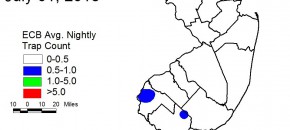Click to View | Download Report 7-4-15 Potato Disease Forecasting Report We will be tracking DSVs for Late blight development and calculating P-days for initiating the first early blight fungicide application. The first late blight fungicide application is recommended once 18 DSVs accumulate from green row. Green row typically occurs around the first week in May […]
Continue reading...Quintec: Now Registered for Bacterial Leaf Spot in Tomato
Quintec is now registered for suppression of bacterial leaf spot in tomatoes. See label for details. ATTENTION • This recommendation is made as permitted under FIFRA Section 2(ee) and has not been submitted to or approved by EPA. • It is a violation of federal law to use this product in a manner inconsistent with […]
Continue reading...Vegetable Disease Briefs – Cucurbit downy mildew ALERT – 7/3/15
Cucurbit downy mildew was reported on watermelon in Dorchester County, Maryland and Sussex County, DE on 7/2. This is the first report of cucurbit downy mildew in the region to date. The most recent reports of cucurbit downy mildew on the east coast have been in cucumber and watermelon. There are at least 5 or 6 […]
Continue reading...Cranberry: Post-bloom Insect Pest Control Recommendations
As we approach the end of bloom, growers should consider the need for any post-bloom applications. The main pest targets for these applications are mainly Sparganothis fruitworm and spotted fireworm.
Continue reading...Fruit IPM Report 6-30-2015
Peach Oriental Fruit Moth (OFM): We are between 2nd and 3rd generation broods in southern counties, but still treating emerging larvae in northern counties. Growers who have trap counts that are less than 6 moths per trap can skip insecticides that are intended for OFM. If trap counts are higher, then time your sprays according […]
Continue reading...Veg IPM Update: Week Ending 7/1/15

Sweet Corn We are between European corn borer (ECB) adult generations at this time. Only scattered individuals are being captured throughout NJ (see ECB map). ECB infestations are still present in some sweet corn plantings, but whorl stage corn is now largely free of ECB injury. As always, consider treating when the number of infested […]
Continue reading...